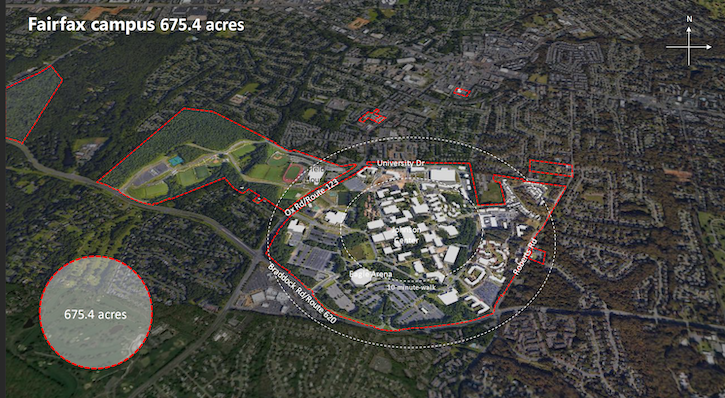
A slide from one of the Powerpoints analyzing the university's three campuses.
In its third virtual Master Plan Engagement Session, George Mason University explored future demographic and workforce projections, closing the analysis work in the preparatory phase of a two-year master planning process that began in early 2020.
The demographic information will assist Mason in understanding potential future enrollments and thus determining the optimal ways to use its campuses and resources in the coming decades to achieve the university’s objectives.
“We’re very excited about where we’re headed,” said Senior Vice President Carol Kissal, adding that the plan’s more detailed second phase will kick off in early 2021. “The master plan is a vehicle by which we will implement our strategic plan.”
Qian Cai, director of the Demographics Research Group at the University of Virginia’s Weldon Cooper Center for Public Service, shared three major conclusions from her group’s analysis: Mason’s programs are well aligned with the state’s labor needs in the coming decades. Demographic shifts will slow Mason’s rate of growth. And, as a result of these trends, Mason’s future capital investment should likely be heavily influenced by strategic and capital renewal factors, rather than simply reacting to meet growth needs.
Other findings from the demographic research:
- More than half of Mason freshmen come from the 18 counties and cities that comprise Northern Virginia. The region provides one-third of the state’s population—including 40% of the state’s under-18 population.
- 72% of Mason graduates in the Class of 2018 were from Northern Virginia.
- While Mason’s future enrollment growth will continue to support Virginia’s needs, aggressive growth targets will require additional focus on out-of-state and international students. Depending on these factors, future enrollments will likely grow from a 2019 enrollment of 39,000 to between 40,000 and 45,000 by the Weldon Cooper estimates, and up to 50,000 students by the university’s internal estimates, over the next 20 years.
- 35% of jobs in Virginia in 2026 will require at least a bachelor’s degree, up from 33% in 2016.
- The jobs expected to experience the fastest rate of growth in Virginia are human services (such as social workers and mental health professionals), health sciences and information technology.
- Business management and administration, IT and health sciences are projected to add the most jobs.
Mason will consider these data points, along with other findings, as the master planning process continues.
“The conclusion of this phase,” said Gregory Janks, the consultant who led the presentation, “is not to identify the answer, or solution, or the plan, but rather the range of reasonable possibilities for development of the physical campuses the university should continue to study and evaluate over the next year.”
